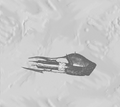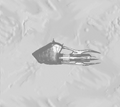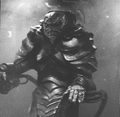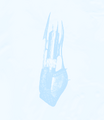Kilrathi Tactics
| Common Confederation and Kilrathi Ships Relative Size and Silhouette Recognition Chart | |
|---|---|
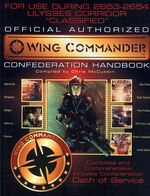
| |
| Book | Wing Commander Confederation Handbook |
| Previous | Semi-Annual Report to Confederation Headquarters Detailing Casualties Among the 88th Fighter Wing Assigned to CS Tiger Claw |
| Next | Secret Files |
| Pages | 84-91 |
Text
SCREEN 1
| query “kilrathi tactics” media=oti | level=CONFIDENTIAL sort=most recent | return=1
Document C776b-12, #12 in a series, published by the Office of Tactical Intelligence
In planning effective offensive and defensive operations against the Kilrathi, it is first necessary to understand the underlying principles that guide Kilrathi tactical decisions. And before those principles can be understood, it is necessary to understand how the Kilrathi mind works.
Kilrathi are not human beings and do not think or react like human beings. The presuppositions behind their tactical philosophy are rooted in their racial evolution.
Before discussing the presuppositions of Kilrathi tactics, a vital distinction must be drawn. Kilrathi are neither animals nor machines. They are highly intelligent, adaptable and self-aware sentients. The Kilrathi understand the patterns of their thought processes better than we ever can, and they are fully capable of designing and carrying out tactics that specifically avoid their normal patterns of behavior.
Understanding the patterns of Kilrathi tactical assumptions can be an invaluable tool, particularly in large-scale or impromptu actions, but it can be a fatal error to assume that the Kilrathi will always behave according to these patterns. The Kilrathi are descended from predators —pack-hunters. Humans are also descended from predators, but our ancestors were huntergatherers.
Early Kilrathi ancestors reached the top of the food chain much quicker than proto-humans did.
Kilrathi are naturally predisposed to attack over defense, and to ambush over attack-in-force. They are natural guerrilla fighters.
Proto-Kilrathi hunting packs would conceal themselves along known game-trails, lie in wait until a herd of food-animals passed by, identify the weakest, most vulnerable prey, and execute a coordinated attack. Early humans also used similar tactics, of course, but not until they achieved sentience and began to make weapons—three or four million years ago. Kilrathi have been hunting in this fashion, using instinct and natural weaponry, for at least 10 million years.
SCREEN 2
| query “kilrathi tactics” source=mil.archive.oti.dbase05A-2653.kilrathi.C776b-12.12
This means that pack-hunting tactics are very deeply ingrained in the Kilrathi psyche. Again, anything the Kilrathi instinct suggests, the Kilrathi intellect can overrule, but the pack-hunter paradigm is the one that comes the most naturally to the Kilrathi, and therefore the one they will turn to under stress, or when they believe they have the advantage.
Some general principles are implied by the evolutionary psychology of the Kilrathi. These general principles are supported by the majority of current after-battle debriefings.
Kilrathi are most comfortable attacking in groups. In groups of three or more, Kilrathi warriors will often display suicidal courage, and engage numerically superior forces. However, a lone Kilrathi (and sometimes a pair) will tend to avoid contact, even against an evenly matched enemy.
Kilrathi have a natural affinity for the ambush. A lone Kilrathi is frequently a decoy planted to lure opposing forces into an ambush situation.
Kilrathi will sometimes fixate on a wounded enemy, pursuing it to the death, while ignoring more dangerous, undamaged opponents. This happens enough that Confed tacticians have given it a name . . . it is called a “blood frenzy.”
Because of their affinity for group tactics, Kilrathi are not naturally prone to sabotage or spy operations involving the insertion and action of a single operative.
The Kilrathi are, of course, fully aware of these tendencies in their psyche—they have been exploiting them against each other in inter-clan warfare for millennia. As a race, they have developed numerous social constructs designed to bypass these racial tendencies when it is advantageous to do so. However, these social constructs, in turn, also represent trends in Kilrathi behavior which can be successfully exploited in battle if fully understood.
These behaviors include:
- Obey without question
- Focus on the strongest
- Respond to challenge
SCREEN 3
| query “kilrathi tactics” source=mil.archive.oti.dbase05A-2653.kilrathi.C776b-12.12
Obey without question
This is the most basic and pervasive social tenet of Kilrathi martial culture. Imagination and creativity are only encouraged in senior commanders and nobles. Line troops are trained to simply follow orders, specifically and without question or interpretation. The conceptual basis for this custom, it is believed, is the idea that a warrior given specific instructions can concentrate on fulfilling them, to the exclusion of other distractions, while a warrior given more general goals may become distracted by instinctive hunting behaviors, to the detriment of the overall strategic mission. The advantage to be seized here by the enemies of the Kilrathi is that if the opposing force can successfully make the Kilrathi mission goals unachievable or logically impossible, the Kilrathi force will sometimes be thrown into complete chaos, particularly if not under the direct supervision of a dominant leader.
Focus on the strongest
The Kilrathi hunting instinct to run down the weakest opponent has been thoroughly discussed. The strategic inappropriateness of such behavior in warfare—leaving the strongest and most dangerous members of the opposing force free to react, while focusing on the weakest—was obvious to the Kilrathi from the very earliest period of their social development. The solution was a custom that has become one of the central principles of all Kilrathi tactics—focus an attack on the enemy’s strongest asset first. This tendency can be exploited if the Kilrathi can be deceived about where the strongest asset of an opposing force actually lies. Another potentially viable tactic can involve putting the strongest asset in the forefront of the battle, in a strong defensive posture, allowing the remainder of the force to execute a coordinated attack on the flanks while the Kilrathi forces are focused on overcoming the primary target’s defenses.
“. . . I serve my Hrai and Lord
With my tongue I offer fealty
With my claws I unsheathe victory.”
— From a Kilrathi oath
Wording in these oaths varies from clan
to clan, but the theme of unquestioning
obedience remains constant.
SCREEN 4
| query “kilrathi tactics” source=mil.archive.oti.dbase05A-2653.kilrathi.C776b-12.12
“My claws do not know shame
For I am a warrior of Kilrah . . .
And offer up my life for honor.”
Recovered Kilrathi writings, both military and
non-military, reference honor and shame,
often linked with combat to the death. The
shame/honor dichotomy is thus made central
to Kilrathi martial philosophy.
Respond to challenge
A Kilrathi warrior must answer a challenge to combat. Reasonable precautions may be taken to ensure that a challenge is not a veiled trap, but in general any challenge or insult is grounds for a struggle to the death. Such behavior is not only legal and accepted in the Kilrathi military, it is in fact punishable by death for a warrior to back down from single combat. It is theorized that presentient Kilrathi displayed dominance patterns typical of pack-hunters, whereby a smaller or inferior hunter would respond with submissive displays to any challenge from a dominant pack-leader. This dominance/submission behavior still underlies many Kilrathi institutions, from the Imperial Throne on down, but it is not tenable in a warfare context, where it may be necessary for lesser warriors to engage obviously more potent enemies. Therefore, Kilrathi are conditioned to respond violently to any challenge to their prowess or honor. (This general rule is greatly complicated in the specific case of Kilrathi commanders and their subordinates. However, the very complex codes that govern challenge/submission behavior between commanders and inferiors is not germane to this discussion.) This conditioning can be exploited in battle through the use of verbal taunts (under conditions where interspecies communication is possible) or by displays of reckless courage. Such behaviors can sometimes distract members of a Kilrathi force from their primary objectives. (There is, of course, significant risk to the challenger in most such situations.)
SCREEN 5
| query “kilrathi tactics” source=mil.archive.oti.dbase05A-2653.kilrathi.C776b-12.12
Space Tactics
Kilrathi naval strategy tends to view capital ships as more defensive than offensive assets, and as more strategic than tactical in function. The bulk of the offensive effort in a Kilrathi naval engagement is carried by fighters and fighter-bombers. Cap ships are used as staging platforms, or for long-range missile bombardment of planetary targets, permanent space stations and opposing cap ships.
If assaulted by a task force of opposing cap ships, a Kilrathi ship usually tries to withdraw under cover of its own guns and scrambled escort fighters. Most Kilrathi battleships larger than a destroyer incorporate a hangar and carrier deck from which escort fighters may be scrambled. Kilrathi battleships almost never engage in a pitched gun- or torpedo-battle with an equivalent opposing force.
The exception to the above is the Kilrathi destroyer, which (much like its Confed counterpart) is a small, heavily armed battleship with no carrier capacity. Destroyers are used for fleet defense—they provide screening actions for the carriers in a battle group, to prevent opposing forces from making direct assaults on the strategically vital carrier decks.
In fighter combat, the Kilrathi are at their most dangerous. They use the same tactics in space that their hunter ancestors used against larger, faster prey in the primordial past. The Kilrathi tend to attack in tight formations (which can make them vulnerable to guided missile barrages launched early in the engagement), surrounding and overwhelming their opponents. They will often make use of decoys, sending one fighter out to engage the enemy one-on-one, then assume a defensive posture, hoping the enemy will chase it while two, three or more fighters get on the pursuer’s six.
Kilrathi fighters are optimized for speed and maneuverability, and can be almost impossible to run down if they go purely on the defensive. In such situations, if simple marksmanship fails, the Kilrathi defender should be engaged with a guided missile, or
SCREEN 6
| query “kilrathi tactics” source=mil.archive.oti.dbase05A-2653.kilrathi.C776b-12.12
caught in a crossfire. Sometimes the evading Kilrathi can be taunted into going on the offensive, if the attacker has a sufficient command of Kilrathi psychology.
All Kilrathi warriors are trained as both soldiers and pilots, but only the best pilots are actually assigned to fighters. Kilrathi honor their elite fighter pilots even more than Confed honors its Aces, and a particularly notable Kilrathi hero will often be given a personalized fighter by the leader of their clan, with individualized markings and (often) technical innovations designed to optimize the Ace’s fighting style. Any Kilrathi fighter with anomalous markings, particularly if behaving in a particularly aggressive manor or displaying atypically high performance, should be treated as an extreme threat—Kilrathi Ace status is not bestowed lightly, and those who earn it are genuinely dangerous.
Boarding Actions
In ship-to-ship boarding actions, Kilrathi tend to enter explosively and advance aggressively. A Kilrathi boarding party consists of about four to 20 small units of four to eight warriors each. Once inside the target ship, the boarding party spreads out as fast as possible throughout the ship, destroying anything that stands in their way. This aggressive offense gives the defenders very little time to adjust to changing conditions, but it can also leave the Kilrathi attackers vulnerable to being cornered or bracketed by alert defensive forces.
In boarding parties, Kilrathi are typically lightly armed, carrying only the Dor- Chak laser rifle and four to six fragmentation grenades. If engaged in hand-to-hand combat, the Kilrathi usually employ their natural claws. Even armed with a knife or staff, humans are grievously overmatched against Kilrathi warriors in close combat. The threeinch Kilrathi claws are capable of cleanly severing a human spinal column, and the average Kilrathi warrior has sufficient strength to dead-lift about 700 kg overhead.
The best tactic against Kilrathi boarders is to isolate the units, cut them off, pin them down and destroy them. Kilrathi units are optimized for offense, not defense, and if they can be immobilized they become much less dangerous.
SCREEN 7
| query “kilrathi tactics” source=mil.archive.oti.dbase05A-2653.kilrathi.C776b-12.12
Kilrathi Combat Armor
For at least 1000 years before they discovered space flight, the standard Kilrathi military uniform has been a suit of jointed metal plates. Today, except for the materials used, a spacefaring Kilrathi warrior wears the same uniform that his ancestors wore twelve centuries ago.
The basic structure of the armor remains steel plates, although a sophisticated alloy is now used. Also, the plates are coated with a plastic film that disrupts many energy weapons and also offers some protection against hard radiation. A full suit of Kilrathi armor (with helmet) weighs about 45 kg.
The interior of the suit is coated with fiber “hairs” that interlock under life-support conditions to seal off the suit from atmosphere and heat loss. Life support systems are integrated into the suit, and are rudimentary compared to similar human devices. An external breathing supply is not necessary except for protracted missions, as the Kilrathi metabolism and the filtering action of the semi-organic “hairs” allows them to re-breathe the atmosphere within the suit itself for several hours. Under normal circumstances, the only electronic device in a Kilrathi armor suit is the helmet radio, powered by a photonicly charged crystalline power supply.
One unusual feature of Kilrathi armor is that the tips of the fingers are usually kept exposed, to allow the warrior to use his extendible claws in close combat.
The helmet visor is coated with a polarizing agent (very similar to the transparent plastic coating over the armor itself) which provides excellent protection against glare. This is an important consideration, since Kilrathi eyes are optimized for a lower level of light than human.
photonicly charged crystalline power supply
SCREEN 8
| query “kilrathi tactics” source=mil.archive.oti.dbase05A-2653.kilrathi.C776b-12.12
Dor-Chak Laser Rifle
The standard Kilrathi sidearm in shipboard operations is a light energy weapon called the Dor-Chak (“Striking Bird”) in the Kilrathi tongue. It usually weighs about 6 kg, and measures 29 cm from barrel-tip to the end of the stock. (Some clans wield variant Dor-Chaks, which may look somewhat different from the standard model, but most function virtually identically.) It is believed that the Dor-Chak, in its modern form, was developed by the Kilrathi 50 to 100 years before contact with humanity.
The Dor-Chak is a multifunction weapon. There’s a short-range, wide-beam setting (good for about 10 meters against unarmored targets, with a spread of about 2 meters), a long-range narrow-beam setting (able to penetrate an unarmored human target at 200 meters), plus a 1-meter torch mode, for cutting through hatches and bulkheads. Its crystalline power supply is good for about 20 minutes of continuous use, after which it must be discarded and a new one slotted into its place. Most Kilrathi warriors go into battle carrying at least five fully charged power supplies for their Dor- Chak.
Confed’s M-47 semiautomatic laser, which is quickly becoming the standard weapon for planetary operations, is based directly on technology originally created by the Kilrathi for the Dor-Chak.











